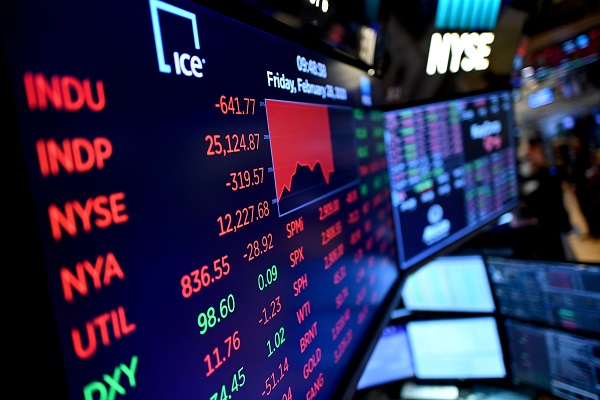Market snapshot: inflection point or dead cat bounce?
After one of the most dramatic stock market slumps, share prices are on the way up, but can the recovery last? ii's head of markets has the latest from Wall Street, Asia and London.
8th April 2025 08:28
by Richard Hunter from interactive investor

A mixed close in the US was followed by some strength in Asia which washed over to the UK market, but investor skittishness and volatility remain high.
The moves were relatively benign compared to the experience of recent days, but underneath the bonnet there were wild gyrations, with the Dow Jones index posting its largest ever intraday swing. Early reports apparently emanating from social media suggested that a pause on tariffs was imminent, which sent markets higher, only for this to be followed by a swift rebuttal from the White House which reversed any potential gains. Later comments from the President threatening to escalate tariffs even further against China kept global investors on high alert.
- Invest with ii: What is a Managed ISA? | Open a Managed ISA | Transfer an ISA
In addition, some of the weakness seen in the bond and gold havens over the day were attributed to investors needing to raise funds for margin calls to cover their losses elsewhere. This rotation has been seen before and can turn out to be a self-perpetuating cycle and is one which could put further pressure, if it were needed, on markets globally.
It is far too early to say whether the reduced market falls represent an inflection point, or whether they are simply a classic “dead cat bounce”. The volatility within the US trading session in particular suggests that either is possible, especially since further tariff announcements to follow could move sentiment in either direction.
Indeed, many investors have noted – with some exasperation – that unlike previous crises where a confluence of factors came together to cause extreme market weakness, this set of events is largely due to the actions of just one person. To some extent, global indices are at the mercy of the President, and the growing backlash which the US is beginning to experience in terms of retaliatory tariffs and increasingly aggressive rhetoric are not even near the end of the beginning.
- 10 hottest ISA shares, funds and trusts: week ended 4 April 2025
- Insider: big director deals at Glencore, Diageo and Vistry
- Sign up to our free newsletter for investment ideas, latest news and award-winning analysis
Despite finishing marginally higher on the day, the Nasdaq remains down by 19.2% so far this year and firmly in bear market territory with a decline of 23% since its relatively recent record high. Meanwhile, the S&P500 and Dow Jones have fallen by 14% and 10.8% respectively in the year to date.
Asian markets were broadly higher overnight, led by a 6% spike in the Nikkei 225 which nonetheless leaves the Japanese index down by 16% this year. The rally seems to be based on hopes that the talks with the US over the coming days will result in some concessions, with the economy largely dependent on exports with the States being a major and important trade partner.
China also ramped up its own retaliatory rhetoric and is showing little sign of succumbing to the President’s threats. It has promised its own as yet unspecified countermeasures in addition to the tariffs already announced, alongside which there is the possibility of further state stimulus to underpin the domestic economy. In any event, the outcome as it stands will be ugly and the potential for reduced demand has hit commodity prices in general, with the likes of oil already having declined by 13% this year.
- Bear markets: what, why and how
- Stockwatch: four defensive shares to consider amid market wreckage
- Shares for the future: here’s how I rank this simple AIM stock
The FTSE100 staged a firm recovery in early trade, although insufficient to reverse the losses of the previous day let alone in the year to date, where the index has now suffered a 4.5% decline. The primary index is now some 12% lower than the record closing high recorded just over a month ago, and the speed of this move into correction territory is symptomatic of broad market frailty.
There was some recuperation for the likes of Rolls-Royce Holdings (LSE:RR.) and BAE Systems (LSE:BA.), which had borne the brunt of yesterday’s selling, with the marginal recovery seen in the Nasdaq at the close lending some support to both Scottish Mortgage Ord (LSE:SMT) and Polar Capital Holdings (LSE:POLR). After some recent weakness, there was also evidence of bargain hunting among stocks such as International Consolidated Airlines Group SA (LSE:IAG) and Glencore (LSE:GLEN), with some investors opting to choose this as a buying opportunity.
These articles are provided for information purposes only. Occasionally, an opinion about whether to buy or sell a specific investment may be provided by third parties. The content is not intended to be a personal recommendation to buy or sell any financial instrument or product, or to adopt any investment strategy as it is not provided based on an assessment of your investing knowledge and experience, your financial situation or your investment objectives. The value of your investments, and the income derived from them, may go down as well as up. You may not get back all the money that you invest. The investments referred to in this article may not be suitable for all investors, and if in doubt, an investor should seek advice from a qualified investment adviser.
Full performance can be found on the company or index summary page on the interactive investor website. Simply click on the company's or index name highlighted in the article.